Impacto de la evaluación por pares en línea y creación de narrativas digitales: Reduciendo el desgaste académico y mejorando el compromiso y la autoeficacia del aprendizaje
##plugins.themes.bootstrap3.article.main##
Keywords
Evaluación por pares en línea, Narrativa digital, Desgaste académico, Compromiso con el aprendizaje, Autoeficacia en el aprendizaje
Resumen
La tecnología digital ha aportado diversas formas y perspectivas a la educación, ya que su integración en la enseñanza promueve enfoques más diversos e innovadores, lo que contribuye a mitigar el desgaste académico de los estudiantes. Con el objetivo de reducirlo y mejorar su compromiso y autoeficacia en el aprendizaje, así como de superar las limitaciones inherentes a modelos de enseñanza habituales, este estudio se propone transformar los métodos tradicionales de evaluación— predominantemente basados en calificaciones obtenidas en exámenes— mediante un enfoque que ofrezca a los estudiantes múltiples oportunidades de expresión. Este se centra en valorar los cambios y el crecimiento en los procesos de aprendizaje de los estudiantes; fomentar su aprendizaje cognitivo de orden superior y profundizar en sus experiencias de aprendizaje en general.
El trabajo adopta una combinación de evaluación por pares en línea y narrativa digital en el contexto del curso electivo de pregrado “Entrenamiento Integral en Lengua Española”, impartido por el Departamento de Lengua y Literatura Españolas de la Universidad Providence en Taiwán. A lo largo de un semestre, el estudio investiga cómo el docente integra, de manera progresiva, la evaluación por pares en línea y la narrativa digital en el currículo. Asimismo, examina y analiza su impacto en el desgaste académico de los estudiantes, así como en su compromiso y su autoeficacia en el aprendizaje. Simultáneamente, se busca comprender los desafíos, las transformaciones y la retroalimentación experimentados por los estudiantes como resultado de este enfoque. Además, se exploran las dificultades y desafíos a los que el docente tiene que hacer frente durante la implementación de esta actividad didáctica, así como las estrategias empleadas para superarlos. En definitiva, la investigación realiza un análisis exhaustivo de la retroalimentación estudiantil respecto a este método de enseñanza, así como de las reflexiones del docente, proporcionando, finalmente, recomendaciones didácticas específicas.
Referencias
Bandura, A. (1986). Social Foundations of Thought and Action: A Social Cognitive Theory. New Jersey: Prentice Hall.
Bandura, A. (1994). Self-efficacy. In V. S. Ramchaudran (Ed.), Encyclopedia of human behavior (71-81). New York: Academic Press.
Bandura, A. (1997). Self-efficacy: The exercise of control. New York: W. H. Freeman.
Benmayor, R. (2008). Digital storytelling as a signature pedagogy for the new humanities. Arts and Humanities in Higher Education, 7(2), 188-204.
Bloom, B. S. (1956). Taxonomy of Educational Objectives, Handbook: The Cognitive Domain. New York: David McKay.
Chang, D.-F. (2015). Students in mass higher education: Effects of student engagement in Taiwan. In J. C. Shin, G. A. Postiglione y F. Huang (Eds.), Mass higher education development in East Asia (189-205). New York: Springer Publishing Company.
Dale, E. (1946). The cone of experience. In Audio-visual methods in teaching. In Ely, D. P. & Plomp, T. (Eds.), Classic Writings on Instructional Technology (169-180). Englewood: Libraries Unlimited, Inc.
Decuyper, S., Dochy, F. y Van den Bossche, P. (2010). Grasping the Dynamic Complexity of Team Learning: An Integrative Model for Effective Team Learning in Organisations. Educational Research Review, 5, 111.
Glanville, J. L. y Wildhagen, T. (2007). The measurement of school engagement. Educational and Psychological Measurement, 67(6), 1019-1041.
Gunuc, S. y Kuzu, A. (2015). Student Engagement Scale: Development, reliability and validity. Assessment & Evaluation in Higher Education, 40(4), 587-610.
Kollar, I. y Fischer, F. (2010). Peer assessment as collaborative learning: A cognitive perspective. Learning and Instruction, 20(4), 344-348.
Lai, C.-L. y Hwang, G.-J. (2015). An interactive peer-assessment criteria development approach to improving students’ art design performance using handheld devices. Computers & Education, 85(2015), 149- 159.
Lai, C.-Y. (2016). Training nursing students’ communication skills with online video peer assessment. Computers & Education, 97, 21-30.
Lingard, H. C., Yip, B., Rowlinson, S. y Kvan, T. (2007). The experience of burnout among future construction professionals: A crossnational study. Construction Management and Economics, 25(4), 345-357.
Maddux, J. E. y Gosselin, J. T. (2003). Selfefficacy. In Leary, M. R. & Tangney, J. P. (Eds.), Handbook of self and identity (218- 238). New York: The Guilford Press.



